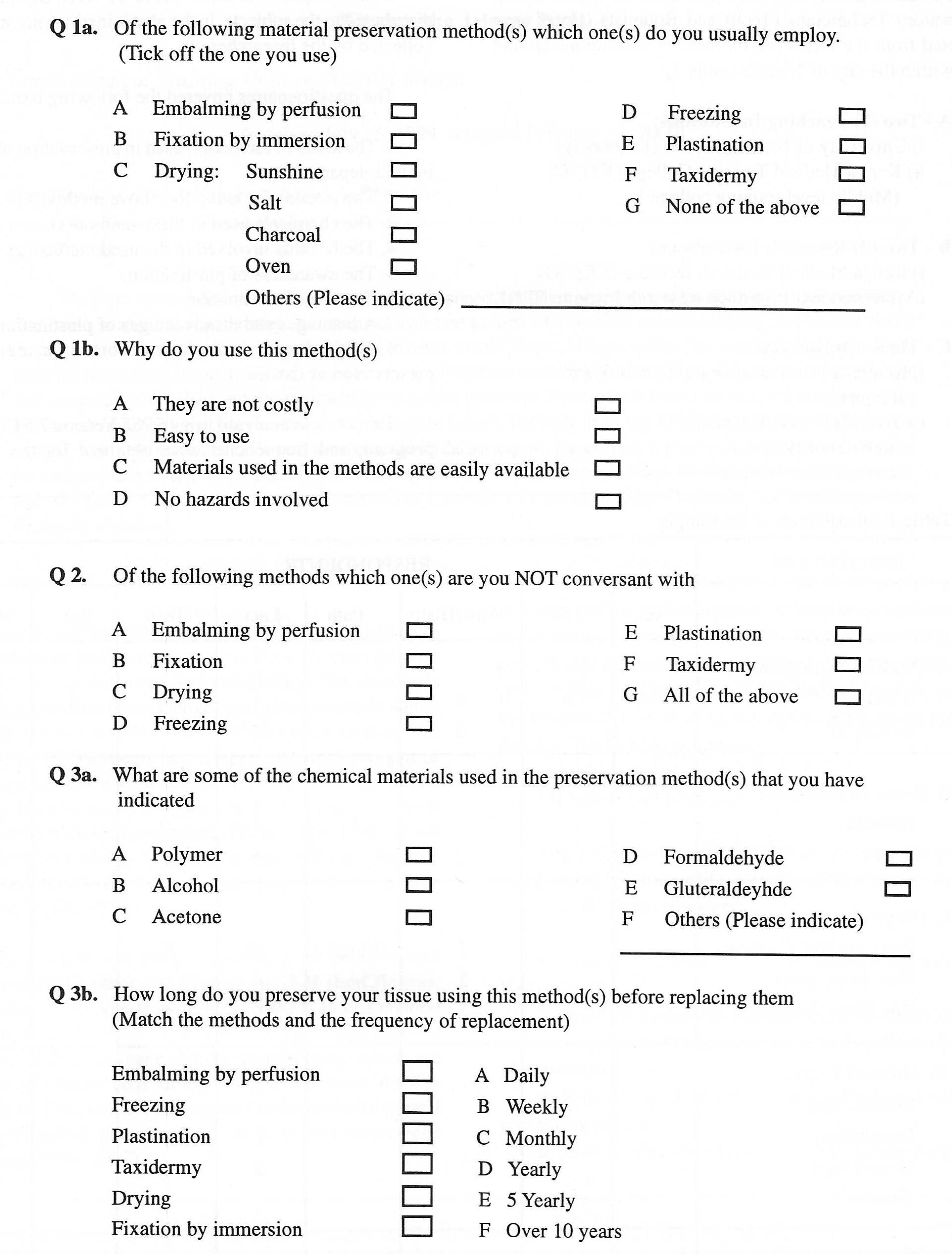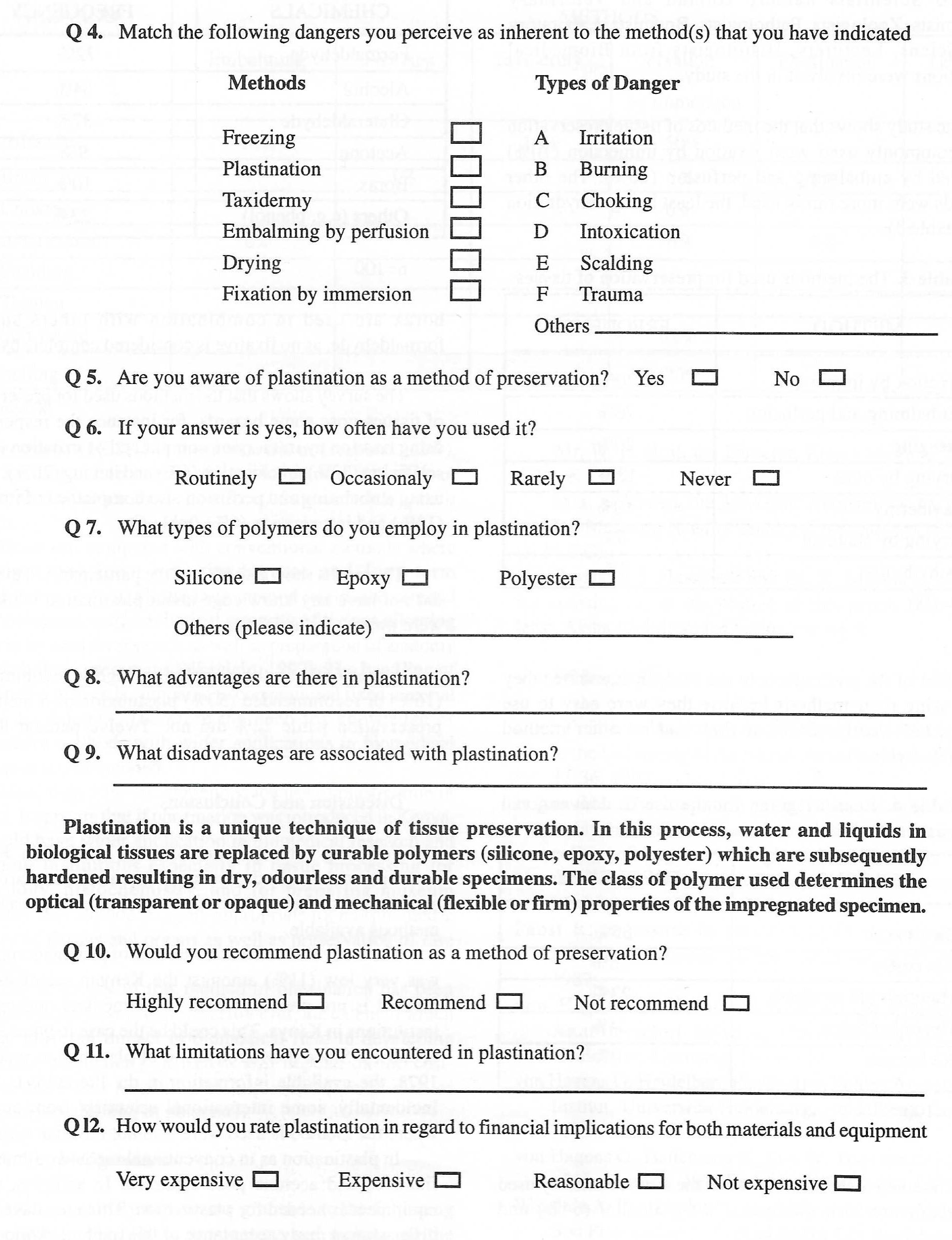Kenya Medical Training College, Nairobi, Kenya
This paper reports a descriptive survey carried out on the present methods of preservation of biological tissues and awareness of plastination, as a method of preservation. The study was carried out amongst 100 biomedical scientists randomly sampled from two (2) teaching and two (2) research institutions, the National Museum, two (2) private and one (1) public National hospital in Kenya. It was found that conventional methods such as fixation by immersion (70%); and embalming (26%) with formaldehyde and or gluteraldehyde were commonly used for long term preservation of tissues in these institutions. These methods were found to be less costly, easy to use and the only method(s) available even though they pose some hazards. The study found that 85% of the respondents did not know anything about plastination while 11 % were aware of it, and 4% did not respond. The advocacy of preservation of tissues by plastination has been gradual in developed countries. About 50% recommended the use of plastination in Kenya. However, the extent to which it may make an impact in the developing countries appears to depend on cost effectiveness and feasibility of implementation, as well as provision for training of personnel.
Presented in part at the 6th Interim Conference on Plastination, Rochester, NY, USA, July 11-16,1999.
plastination; Kenya; Africa; preservation;
Kipchumba Jelagat Peris, Box 30195, Nairobi, Kenya. Telephone: 254 02 725 711 / Fax.: 254 02 922 907. Email: kmtc@nbnet.co.ke
![]()



Kenya is a developing country in Africa, and to date the preservation of biological tissues is done by conventional methods such as perfusion and embalming. The chemicals commonly used are formaldehyde and gluteraldehyde which are known to be toxic (Norman, 1986). In these methods the penetration of chemicals into deeper parts of the organ or body depends on the flow of fixatives by perfusion pressure through blood vessels (Logan, 1983). If tissues are well perfused the cells are fixed in situ. Tissues are also preserved by immersion whereby they may be kept in the fixatives for long preservation. The fixatives used poses some hazards to the users (Pabst, 1987).
Plastination is a unique technique of preservation developed by Gunther von Hagens in 1978 (von Hagens, 1979-1984, 1985; von Hagens et al., 1987) . In this method water and lipids in biological tissues are replaced by a polymer such as silicone, epoxy or polyester, which are subsequently hardened resulting in dry, ordorless and durable specimens. The class of polymer used determines the optical and mechanical properties of impregnated specimens (Weiglein, 1996, 1997).
The available information in the literature on plastination is scanty and the method appears to have been used recently in America and Europe (Weiglein, 1997; Cook, 1997). The present study therefore aims at ascertaining the methods of preservation used presently in biomedical institutions and the awareness as well as knowledge on plastination method amongst the Kenyan scientists.
The survey was carried out to review the methods of preservation of tissues and awareness of plastination method. The specific objectives were:
A sample of 100 subjects [Veterinary Anatomist (Vet), Zoologists (Zoo), Human Anatomists / Histologists (Anat/ Histo), Pathologists (Path), Scientists and/or Lecturers (Lect), Laboratory Technicians (Tech) and Botanists (Bot)] were selected from the following biomedical institutions around and within the city of Nairobi (table 1):
Detailed questionnaires (table 2) were designed and distributed to the subjects, in the above institutions, and were collected by the researcher.
The questionnaires covered the following issues:
The data was analysed using SPSS Version 7.5 Computer program, and frequencies were obtained for the various objectives.
| INSTITUTION | RESPONDENTS | |||||||
| Vet | Zoo | Anat/Histo | Path | Lect | Tech | Bot | TOT. | |
| A. Teaching Institutions i)UON ii) KMTC |
4 | 6 | 6
5 |
4
15 |
4 | 6 | 30
20 |
|
| B. Research Institutions KEMRI ILRI |
1 | 2 | 3 | 1
5 |
1 | 5
8 |
||
| C. Hospitals Kenyatta Nat. Hospital Nairobi Hospital Aga Khan Hospital |
5
2 2 |
(Chief) 1
(Chief) 1 |
10 |
5 1 |
21 3
3 |
|||
| D. Museum Depts. Mammology Ornithology Herpetology Genetic |
1 | 2 | 1 | 1 2 | 1
2 |
4 3
2 1 |
||
| TOTAL | 100 | |||||||
 |
 |
100 Scientists namely Human and Veterinary Anatomists, Zoologists, Pathologists, Botanists, Laboratory Technicians, Lecturers, Histologists from Biomedical institutions were involved in the study.
The study shows that the methods of tissue preservation most commonly used were fixation by immersion (70%) followed by embalming and perfusion (26%). The other methods were more rarely used, the least being dehydration (2%) (table 3).
| METHOD | FREQUENCY |
| Fixation by immersion | 70% |
| Embalming and perfusion | 26% |
| Freezing | 20% |
| Drying by oven | 12% |
| Taxidermy | 10% |
| Drying by charcoal | 6% |
| Dehydration | 2% |
Most of the participants to the study declared that they were using their methods because they were easy to use (35%), less costly (26%) or they had no other method available (table 4).
| REASONS | FREQUENCY |
| Easy to use | 35% |
| Not costly | 26% |
| Materials are available | 23% |
| The only choice | 24% |
| No hazards | 10% |
The study also established that the most commonly used chemicals are formaldehyde (72%), alcohol (64%) and gluteraldehyde (37%) (table 5).
| CHEMICALS | FREQUENCY |
| Formaldehyde | 72% |
| Alcohol | 64% |
| Gluteraldehyde | 37% |
| Acetone | 9% |
| Borax | 10% |
| Others (e.g. phenol) | 23% |
Some of these chemicals such as ethanol, acetone and borax are used in combination with others such as formaldehyde, as no fixative is considered complete by itself.
The survey shows that the methods used for preservation of tissues pose some hazards, for instance the respondents using fixation by immersion complained of irritation (50%), self fixing (32%), intoxication (6%) and itching (20%). Those using embalming and perfusion also complained of irritation (18%) and intoxication (6%) (table 6).
| HAZARDS | METHODS | |||||
| Embalming | Freezing | Taxidermy | Fixation by immersion | Plastination | Drying | |
| Irritation | 18% | 10% | 50% | |||
| Burns | 1% | 1% | 1% | |||
| Choking | 6% | |||||
| Intoxication | 6% | 6% | 6% | |||
| Scalding | ||||||
| Trauma | ||||||
| Self fixing | 32% | |||||
| Itching | 20% | |||||
The results show that 89% of the participants in the study did not have any knowledge about plastination while 11% were aware of plastination.
About 66% of the population highly recommended (16%) or recommended (50%) plastination as a method of preservation while 22% did not. Twelve percent did not respond to this question.
For long term preservation of tissues in Kenya, conventional methods are used because they are easy, economical and moreover the only choice of preservation methods available.
The study showed that awareness of plastination method was very low (11%) amongst the Kenyan scientists. This method is not presently used in biomedical and research institutions in Kenya. This could be the case in other African countries. Since the introduction of plastination method in 1978, the available information in the literature is scanty. Incidentally, some international scientists from countries where the method is used were also not familiar with it.
In plastination as in conventional methods, fumes from fixatives and acetone pose a hazard. In addition, special equipment is needed for plastination. This may have been a dissuasion in ready acceptance of this method. Although the recommendation of plastination as a method amongst the participants was high (66%), the hesitancy of those who did not recommend (22%) or those who did not respond (12%), may have been due to lack of knowledge of plastination or fear of the unknown about the effects of the materials to their health.
However, compared with conventional methods where fixation may have been inadequate and long-term preservation is poor, plastination method retains the original morphological and histological integrity of tissues allowing them to be used for research as well as preparation of anatomy and pathology specimens (Weiglein, 1997). The handling of plastinated materials compared to conventional fixed material poses no dangers. Therefore the need for knowledge or alternative methods with wider applications in biomedical studies is recommended.
More than 50% recommended the use of plastination in Kenia. It appears that if plastination was introduced in Kenya, it would have wider application in biomedical research and teaching institutions especially in tissue processing for pathology, histochemistry, and for preparing museum exhibits. This method is highly appropriate for morphometric studies of tissues and organs as well as preservation of rare tissues.
The advocacy of this method of plastination has been gradual in developed countries. However, the extent to which it may make an impact in biomedical field in developing countries, particularly in Kenya will depend on the cost- effectiveness and feasibility of implementation as well as provision for training of personnel.
Acknowledgements
I wish to convey my sincere gratitude to the following who played a big role in nominating and making all the arrangements for me to attend the 6th interim conference on plastination held in Rochester University, New York (USA). Mr. W. K. Boit, the Director, Kenya Medical Training college. Mrs. A. Kimeu, the Academic Registrar (K.M.T.C). Dr. Maswan, Head of faculty, Community Oral Health (K.M.T.C). Professor J. Hassanali and Dr. R. Macharia, (U.O.N), for assisting me in the writing of this paper. Last but not least, Aisha Abdulbari for typing my work.
Cook P: Sheet plastination as a clinical based Teaching Aid at the University of Auckland. Acta Anatomica 158 (1): 33-36, 1997.
https://doi.org/10.1159/000147907
Logan BM: The long-term preservation of whole human cadavers destined for anatomical study. Annals of Royal college of surgeons of England 65: 333, 1983. Norman GR: Science, Public Policy and Media disease. Can Med Assoc J 134: 719-720, 1986.
Pabst R: Exposure to formaldehyde in anatomy: An occupational health hazards. Anat Rec 219: 109-112, 1987.
https://doi.org/10.1002/ar.1092190202
von Hagens G: Technical Leaflets on Plastination. Anatomisches Institut, Universität Heidelberg, Heidelberg, Germany, 1979-1984.
von Hagens G: Heidelberg Plastination Folder. Anatomisches Institut, Universität Heidelberg, Heidelberg, Germany, 1985.
von Hagens G, Tiedemann K, Kriz W: The current potential of plastination. Anat Embryol 175 (4): 411-421, 1987.
https://doi.org/10.1007/BF00309677
Weiglein A: Plastination - a teaching and research tool. J Int Soc Plastination 11 (1): 34, 1996.
https://doi.org/10.1159/isbn.978-3-8055-8714-3
Weiglein AH, Guest Editor: Plastination. A tool for Teaching and Research. Acta Anatomica 158 (1): 5, 1997.
https://doi.org/10.1159/isbn.978-3-8055-8714-3